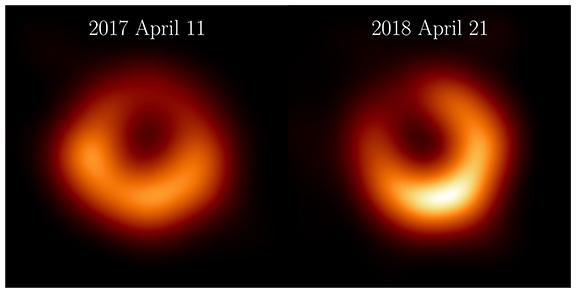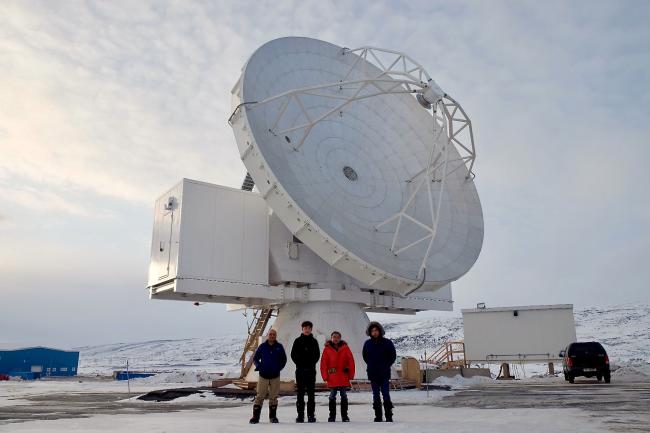Experts
- Dominic Chang
- Michael Johnson
- Paul Tiede
- Iniyan Natarajan
- Dominic Pesce
- Nimesh Patel
- Lindy Blackburn
CfA astronomers helped lead a study discovering changes in the bright ring around M87's black hole, confirming the theoretical understanding of the variable and turbulent flow of material around black holes.

Cambridge, MA--The Event Horizon Telescope (EHT) Collaboration has released new images of the supermassive black hole at the center of the galaxy Messier 87 (M87*) using data from observations taken in April 2018. Participation of the newly commissioned Greenland Telescope, and a dramatically improved recording rate across the array, has allowed the 2018 observations to give us a view of the source that is independent from the first observations in 2017. A new paper published in the journal, Astronomy & Astrophysics, presents new images from the 2018 data that reveal a familiar ring, the same size as the one originally observed in 2017. This bright ring surrounds the apparent "shadow" of the black hole, whose existence is predicted by Einstein’s theory of General Relativity. A clear change in the location of the brightest part of the ring - a shift of 30 degrees compared to the 2017 image - confirms our theoretical understanding of the variable and turbulent flow of material around black holes.
The Center for Astrophysics | Harvard & Smithsonian (CfA) played a crucial role in this work. The Greenland Telescope (GLT) is jointly operated by the Smithsonian Astrophysical Observatory (SAO), which is part of CfA, and by the Academia Sinica Institute of Astronomy & Astrophysics (ASIAA) of Taiwan. The Submillimeter Array, also jointly operated by SAO and ASIAA, continued to be part of the EHT. Michael Johnson from SAO is the Chair of the EHT Science Council, and many CfA scientists worked on the astrophysical interpretation of the new image of M87*.
"A fundamental requirement of science is to be able to reproduce results," says Dr. Keiichi Asada, an associate research fellow at ASIAA. "Confirmation of the ring in a completely new data set is a huge milestone for our collaboration and a strong indication that we are looking at a black hole shadow and the material orbiting around it."
"The first image of a black hole looked so similar to the mathematical predictions that it almost seemed like a fluke," said Dominic Chang, a PhD candidate at Harvard University and member of both the EHT and the Black Hole Initiative in Cambridge, Massachusetts. "Getting the opportunity to make new tests using new data, with a new telescope, and seeing the same structure is a crucial confirmation of our most significant conclusions."
In 2017, seven radio telescope sites around the Earth turned to point in the same direction. These sites made up a global array called the EHT. Their observations resulted in the first image of a black hole. This object, M87*, lies at the heart of the giant elliptical galaxy Messier 87, 55 million light years away from Earth. The image of the black hole revealed a bright circular ring, brighter in the southern part of the ring. Further analysis of the data also revealed the structure of M87* in polarized light, giving us greater insight into the geometry of the magnetic field and the nature of the plasma around the black hole.
A year later, the EHT again pointed at M87*, but with the addition of the GLT.
The new era of black hole direct imaging, spearheaded by the extensive analysis of the 2017 observations of M87*, opens a new window to investigate black hole astrophysics and allows us to test the theory of general relativity at a fundamental level. Theoretical models predict that the material around M87* should be uncorrelated between 2017 and 2018, giving us two separate snapshots of the source. Thus, multiple observations of M87* help place independent constraints on the plasma and magnetic field structure around the black hole and disentangle the complicated astrophysics from the effects of general relativity.

Observers at the Greenland Telescope (GLT), soon after the completion of the EHT run in April 2018. From left to right the observers are Nimesh Patel (SAO), Keiichi Asada (ASIAA), Hiroaki Nishioka (ASIAA), and Chen-Yu Yu (ASIAA). The 12-m diameter GLT antenna is located at the Pituffik Space Base in Greenland. In 2011, the National Science Foundation and Associated Universities, Inc. (AUI)/NRAO awarded this antenna to the SAO, for relocation to Greenland. The GLT project is a collaboration between SAO and ASIAA.
To help accomplish new and exciting science, the EHT is under continuous development. The GLT joined the EHT for the first time in 2018, just five months after its construction was completed far above the Arctic Circle. This new telescope significantly improved the image quality of the EHT array, improving the coverage, particularly in the North-South direction.
"This has been the most challenging telescope project I have been involved in, but it is extremely gratifying to see the GLT successfully working as part of the EHT array," said Nimesh Patel, an SAO astronomer and engineer. "Just a month before the EHT observations of April 2018, we had a group of students visiting the GLT from Qannaq in Greenland, a village north of the telescope site. It was wonderful to see the excitement in the students upon seeing our telescope and learning about black holes. We hope this image of the black hole will continue to inspire them."
The Large Millimeter Telescope also participated for the first time with its full 50 m surface, greatly improving the EHT array's sensitivity. The array was also upgraded to observe in four frequency bands around 230 GHz, compared to only two bands in 2017.
Repeated observations with an improved array are essential to demonstrate the robustness of the findings and strengthen confidence in the results. In addition to enabling groundbreaking science, the EHT also serves as a technology testbed for cutting-edge developments in high-frequency radio interferometry.
The analysis of the 2018 data features eight independent imaging and modeling techniques, including methods used in the previous 2017 analysis of M87* and new ones developed from the collaboration’s experience analyzing Sgr A*.
"One of the remarkable properties of a black hole is that its radius is strongly dependent on only one quantity: its mass," said Dr. Nitika Yadlapalli Yurk, a former graduate student at the California Institute of Technology (Caltech), now a postdoctoral fellow at the Jet Propulsion Laboratory in California. "Since M87* is not accreting material (which would increase its mass) at a rapid rate, general relativity tells us that its radius will remain fairly unchanged over human history. It's pretty exciting to see that our data confirm this prediction."
"The biggest change, that the brightness peak shifted around the ring, is actually something we predicted when we published the first results in 2019," said Dr. Britt Jeter, a postdoctoral fellow at Academia Sinica Institute for Astronomy and Astrophysics in Taiwan. "While general relativity says the ring size should stay pretty fixed, the emission from the turbulent, messy accretion disk around the black hole will cause the brightest part of the ring to wobble around a common center. The amount of wobble we see over time is something we can use to test our theories for the magnetic field and plasma environment around the black hole."
Building on these new results, SAO is leading the design of a transformative upgrade to the EHT. "The next-generation EHT (ngEHT) program will expand the array by adding new radio dishes across the globe and extending observations over many radio frequencies, with a goal of making the first black hole movies," said Sheperd Doeleman, who leads the ngEHT and is the Founding Director of the EHT. “We will all have front row seats to black hole cinema by the end of this decade."
More Information
Work at SAO on the EHT and next-generation EHT is supported through grants from the National Science Foundation, the Gordon and Betty Moore Foundation and the John Templeton Foundation, and a generous gift from the Deepak Raghavan Family Foundation.
The EHT collaboration involves more than 300 researchers from Africa, Asia, Europe, and North and South America. The international collaboration is working to capture the most detailed black hole images ever obtained by creating a virtual Earth-sized telescope. Supported by considerable international investment, the EHT links existing telescopes using novel systems, creating a fundamentally new instrument with the highest angular resolving power that has yet been achieved.
The individual telescopes involved are ALMA, APEX, the IRAM 30-meter Telescope, the IRAM NOEMA Observatory, the James Clerk Maxwell Telescope (JCMT), the Large Millimeter Telescope (LMT), the Submillimeter Array (SMA), the Submillimeter Telescope (SMT), the South Pole Telescope (SPT), the Kitt Peak Telescope, and the Greenland Telescope (GLT). Data were correlated at the Max-Planck-Institut für Radioastronomie (MPIfR) and MIT Haystack Observatory. The postprocessing was done within the collaboration by an international team at different institutions.
The EHT consortium consists of 13 stakeholder institutes: the Academia Sinica Institute of Astronomy and Astrophysics, the University of Arizona, the University of Chicago, the East Asian Observatory, Goethe-Universitaet Frankfurt, Institut de Radioastronomie Millimétrique, Large Millimeter Telescope, Max Planck Institute for Radio Astronomy, MIT Haystack Observatory, National Astronomical Observatory of Japan, Perimeter Institute for Theoretical Physics, Radboud University, and the Smithsonian Astrophysical Observatory.
Contact Information
Michael Johnson
Smithsonian Astrophysical Observatory
Cambridge, MA USA
Tel: +1-541-760-3032
Email: mjohnson@cfa.harvard.edu
Dominic Chang
Harvard University & Black Hole Initiative
Cambridge, MA, USA
Tel: +1 508 963 8551
Email: dochang@g.harvard.edu
About the Center for Astrophysics | Harvard & Smithsonian
The Center for Astrophysics | Harvard & Smithsonian is a collaboration between Harvard and the Smithsonian designed to ask—and ultimately answer—humanity's greatest unresolved questions about the nature of the universe. The Center for Astrophysics is headquartered in Cambridge, MA, with research facilities across the U.S. and around the world.
Media Contact
Peter Edmonds
Interim CfA Public Affairs Officer
Center for Astrophysics | Harvard & Smithsonian
+1 617-571-7279
pedmonds@cfa.harvard.edu
Related News
New Theory May Explain Mysterious “Little Red Dots” in the Early Universe
Runaway Stars Reveal Hidden Black Hole In Milky Way’s Nearest Neighbor
NASA's Hubble, Chandra Find Supermassive Black Hole Duo
Event Horizon Telescope Makes Highest-Resolution Black Hole Detections from Earth
CfA Celebrates 25 Years with the Chandra X-ray Observatory
CfA Astronomers Help Find Most Distant Galaxy Using James Webb Space Telescope
Astronomers Unveil Strong Magnetic Fields Spiraling at the Edge of Milky Way’s Central Black Hole
Black Hole Fashions Stellar Beads on a String
Unexpectedly Massive Black Holes Dominate Small Galaxies in the Distant Universe
Unveiling Black Hole Spins Using Polarized Radio Glasses
Projects
AstroAI
DASCH (Digital Access to a Sky Century @ Harvard)
For that reason, the DASCH (Digital Access to a Sky Century @ Harvard) team are working to digitize the plates for digital storage and analysis. The process can also lead to new discoveries in old images, particularly of events that change over time, such as variable stars, novas, or black hole flares.
GMACS
For Scientists
Sensing the Dynamic Universe
SDU Website